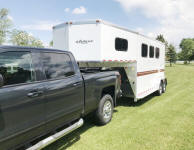
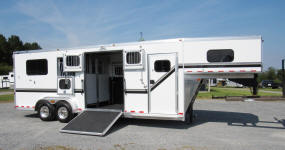
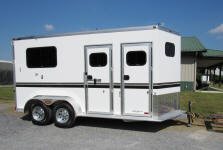
Jamco’s an old favorite returning to Traveled Lane. We started
selling Jamco trailers in 1998. With the economic crash of 2008 and
changing demand, we took on some mid-range products and drifted away
from Jamco for a while. As the economy improved though, we noticed
we were receiving inquiries about Jamco trailers even though they
hadn’t been in our ads or on our website for some time. Traveled
Lane was established as a premium-brands dealer and our Jamco
customers had been very pleased with their trailers, so we decided
it might be time to renew the association. A phone call or two to
get up to speed on the latest product and we were back in the Jamco
business. This section contains some pictures we’ve taken as well as
several pictures used by permission of Jamco. We’ll incorporate more
of our own pictures as various models arrive.
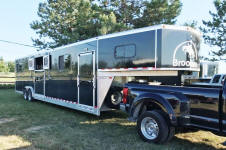
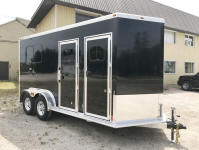
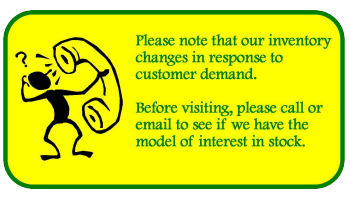
Those of you who came to this page from the What’s New teaser may be
wondering what we meant when we said there’s a new twist in how they
build Jamco trailers. Most trailers feature skin-over-frame
construction. That is, they build a skeleton of small tubes and
cover it with a skin of either aluminum or steel. That’s not how
they build a Jamco. The Jamco fans among you are likely familiar
with their signature interlocking aluminum tube walls. In the past,
those tubes ran horizontally and were stacked, similar to how they
build the walls of a log house. It was hard to mistake a Jamco for
anything else. Jamco still uses the interlocking aluminum tubes, but
since 2014, they’ve been vertical instead of horizontal. Just below,
have a look at the tubes on an 8-horse slant under construction.
(Also, take note of the precise window cutouts. On more than a few
brands, the window cutouts look like they’re done with tin snips.)
The next image to the right is the same trailer after completion.
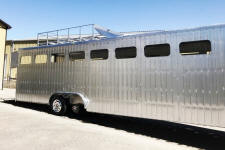
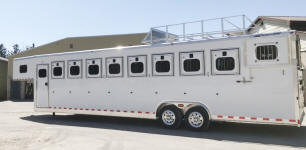
Thanks to robust construction, Jamco trailers have always been very
strong and quiet. Several years ago, some folks sent us
pictures of a Jamco that had been headed to their farm. It got
caught at a railroad crossing, was hit by a coal train at 26 MPH and
pushed sideways quite a distance before the train came to a stop.
It wasn’t their trailer, but they were moved to write because they
were so impressed at how well the trailer and an uninjured horse
came through the collision. Now, the trailer did have a
locomotive-sized (but shallow) dent in the side and it looked like a
chassis rail got tweaked at the contact point, but considering that
the trailer had been broadsided by a train, it was amazingly intact.
In the pictures, the trailer looked normal from 3 sides. The
reason we bring up the “hit by a train” trailer is because Jamco
reports that their current vertical-tube construction (which has
been in production since 2014) is even stronger than the old design.
_small.jpg)
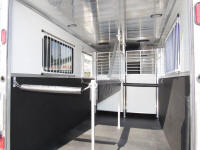
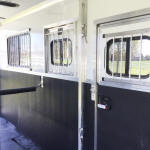
It was fine to leave the old horizontal tubes exposed.
It was a nice form-follows-function look and you could recognize a
Jamco at a glance. But Jamco realized that the vertical
tubes, if left exposed, could look somewhat like a picket fence.
So Jamcos now have smooth inner and outer skins covering the tubes.
In the pictures a couple paragraphs back, we’re showing an 8-horse
slant under construction so you can see the vertical tubes.
Right next to that image is the finished trailer, complete with its
smooth white exterior aluminum skin. (Its interior is skinned
in white as well.) Just above this paragraph are a few
additional examples of finished product.
In the past, the tubes were available only in white or natural
aluminum. White is still the standard exterior color,
but now that there’s a skin over the tubes, if you want an out of
the ordinary color, they can order aluminum sheet with baked-on
finish in a variety of colors (at additional cost, just to be
clear). If you want a black or blue or red (or other) exterior
with standard white interior, it’s easy enough to do. In
fact, polished sheets, offering a near mirror finish, may also be
specified. (In case you’re still not clear as to how
Jamco construction differs from the more common skin over frame
approach, keep in mind that if you left the cosmetic skin off a
Jamco, you’d still have a completely enclosed structure and the
strength of the tube walls. If you left the skin off a
conventional trailer, it would look like your horses are going down
the road in a cage [with widely spaced bars, we might add].)
_small.JPG)
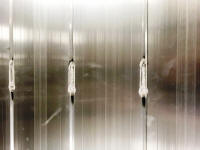
Jamco tells us the aluminum covering skins are bonded to the
structural vertical tubes by an aircraft-grade adhesive.
For most of us, “aircraft-grade” pretty much covers it as far as the
adhesive’s strength, flexibility and temperature tolerance are
concerned, but this method also produces a smooth skin. A
smooth skin usually signifies better build quality, better materials
or both. A skin with ripples and dips is usually a sign
of cost-cutting. Since quality of construction is a major part
of the Jamco appeal, please note also that those tidy welds on the
wall tubes are done by robot, for quality control and consistency.
(And while we’re talking about welds, please note: The wall
tubes of the horse trailers are covered in smooth aluminum on the
interior and exterior. The wall welds are hidden.
Jamco’s premium car haulers and enclosed trailers also feature the
vertical-tube wall construction, but on those, the wall tubes
are left exposed on the interior [see picture on left above].
We think it’s a nice industrial look. Bauhaus even?)
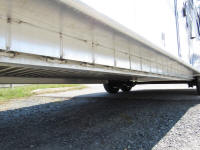
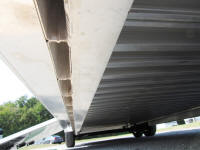
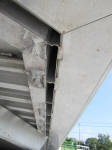
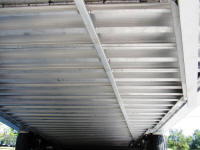
The techies among you might ask (as we did): With all those vertical
tubes, what if water gets inside and freezes? If water infiltrates,
the tubes will drain freely. (Actually, if we recall the statement
correctly from Jamco, it was, “You could pour a bucket of water down
a tube and it would run right out.” To which Traveled Lane adds,
“But please don’t.”) After receiving some trailers, we could
understand their confidence. The bottoms of the tubes are open, as
shown in some of the pictures below. Jamcos are built in Ontario,
Canada. We mention this for two reasons. First, it gets cold in
Canada, so they’re well aware that you don’t want water
accumulating, freezing, expanding and blowing out tubes. And second,
Jamcos are built in a rural area with lots of dirt and gravel roads.
Their home turf is an excellent proving ground for their trailers.
We’ll wrap up our discussion of Jamco’s cut-above construction with
a comment or two about the floor. Their extruded-plank aluminum
floor has integrated I-Beam cross-members every 4.5”. That’s at
least two supports per hoof span. A very strong floor!
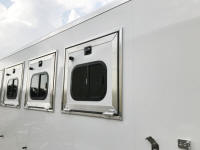
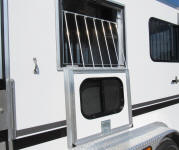
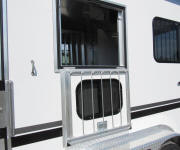
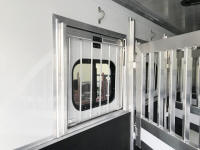
OK, we’ve spoken a lot about Jamco construction. Quality
construction is fine, but if a trailer doesn’t have the features you
need, you likely won’t buy it. Fortunately, Jamco
trailers are loaded with convenience and safety features.
Case in point – Jamco’s drop down feed windows. Drop-feed
windows are common in slant loads, but you can get them in Jamco
straight loads as well and like everything about a Jamco, they’re a
cut or two above the norm. Jamco’s drop-feeds are not
the flimsy bolt-in units that are mostly glass with a little
perimeter frame. Jamco’s drop-feed windows are actual doors,
built by Jamco. They don’t flex. They don’t twist.
Latches, hinges and window guards are appropriately robust.
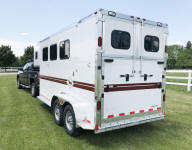
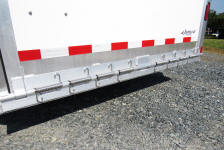
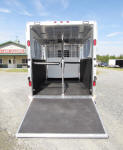
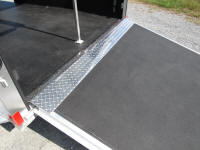
The interlocking-tube walls are a Jamco signature feature. Another
is the ramp hinge cover for a smooth transition as your horses back
off the trailer. If a Jamco is equipped with a ramp, that ramp will
be as tough as the walls, have an effective spring assist and in
most cases be 4.5’ tall. Some other appealing Jamco touches include:
Smooth walls. Smooth ceiling of interlocking panels. Smooth dividers
of various styles. Easily removable stall hardware. Large windows
for great natural light and ventilation. Roof vents. LED running
lights. Dexter EZ Flex axles. Radial tires. Heavy duty fenders.
Aluminum wheels on goosenecks and galvanized rims on bumper pulls.
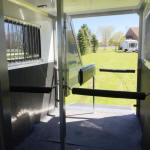
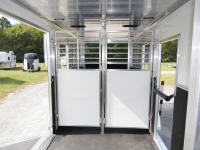
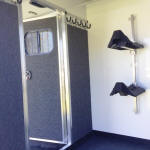
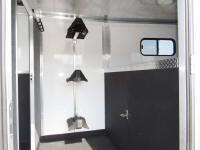
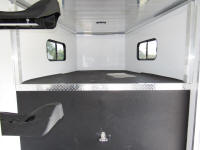
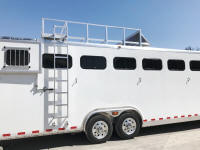
_small.jpg)
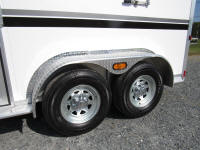
Jamco offers a variety of goosenecks and bumper pulls in straight
load, slant load, side load and side unload configurations. Also,
livestock models, box stall models, Living Quarters shells (slant or
straight load) and more. Every Jamco is built to order, but we try
to keep in stock well-equipped popular configurations for immediate
purchase. The majority of Jamco trailers are in the 1 to 8 horse
range, but they have built and will build larger trailers to custom
order. Jamco’s 2+1 goosenecks (two straight stalls plus a box stall,
with or without dressing room) were great sellers for us in the past
and we expect them to be top sellers now that we’re back with Jamco
for Act II. The 2+1 is roomier and more versatile than a small
trailer, but is compact enough for everyday use. If you don’t see
the trailer or feature that fits your needs, feel free to call or
email us. We and Jamco have plenty of experience in custom builds
and Jamco builds far more than the sample we’re showing here!
Click here to see additional models
and features.
(Information is believed to be accurate at time of preparation, but
specifications subject to change without notice.)
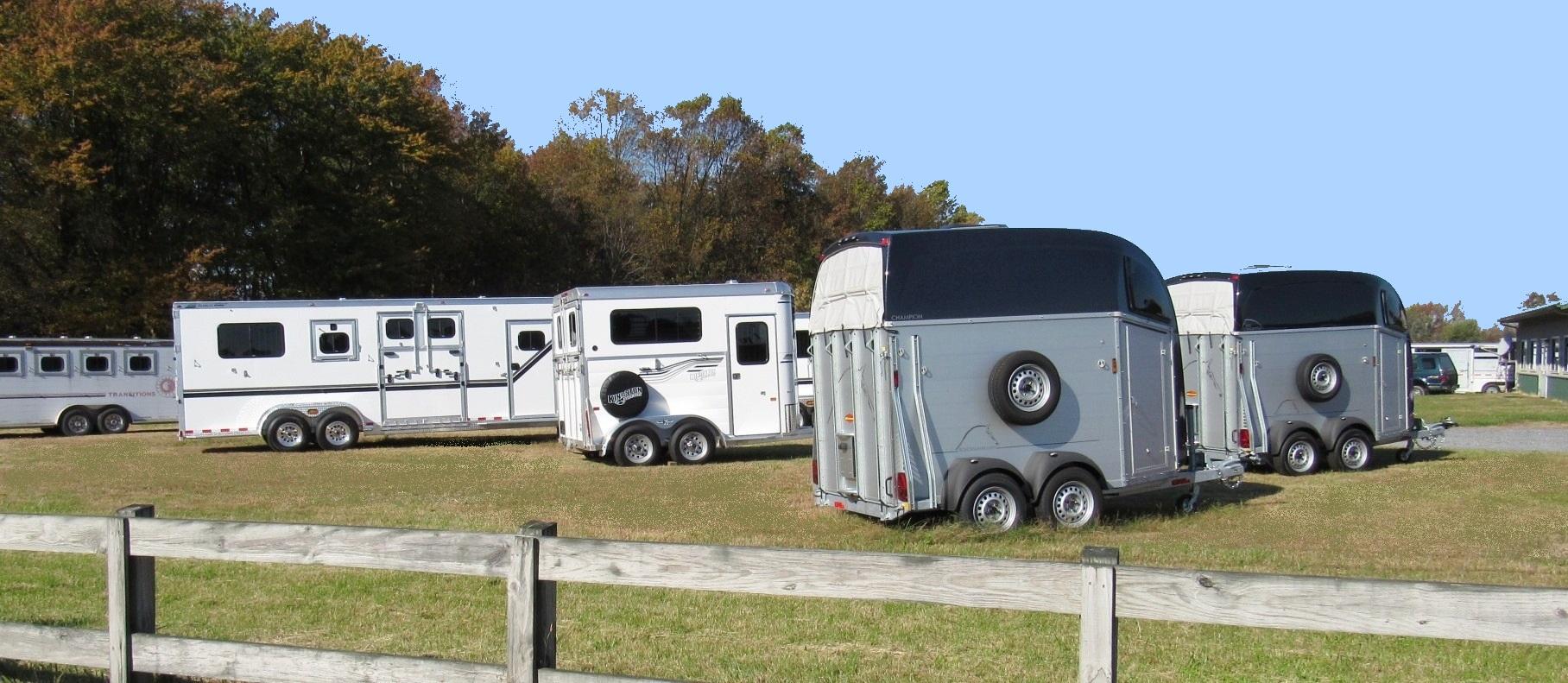
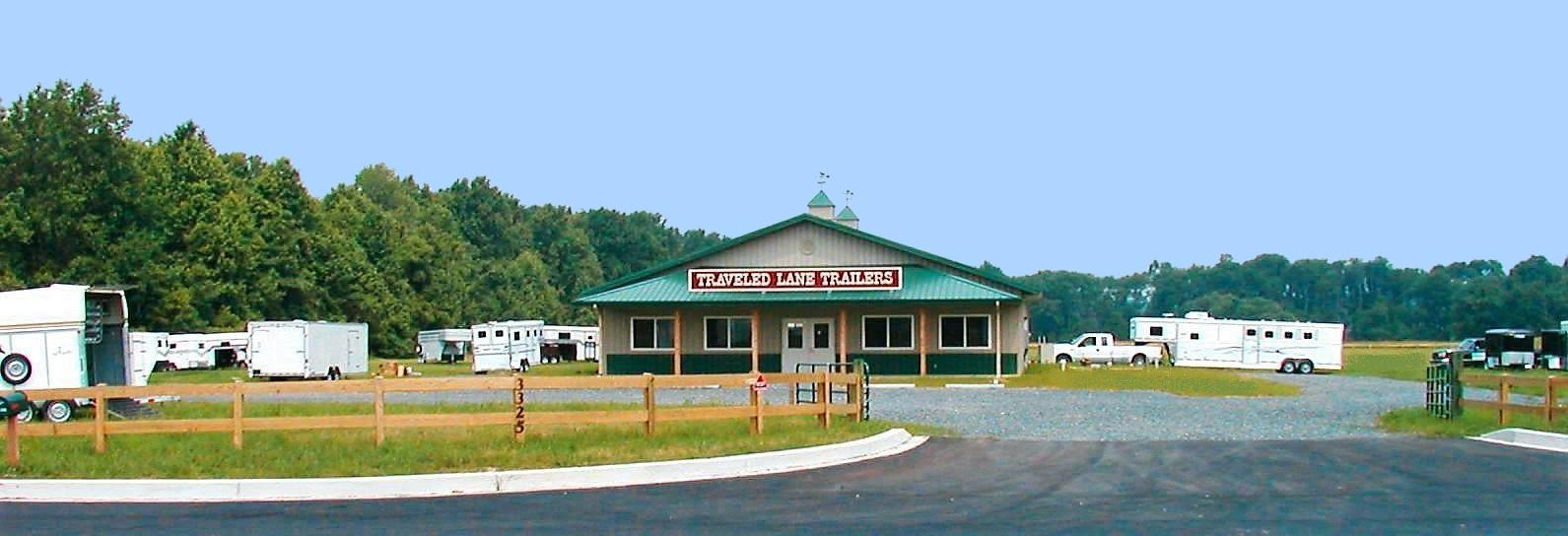
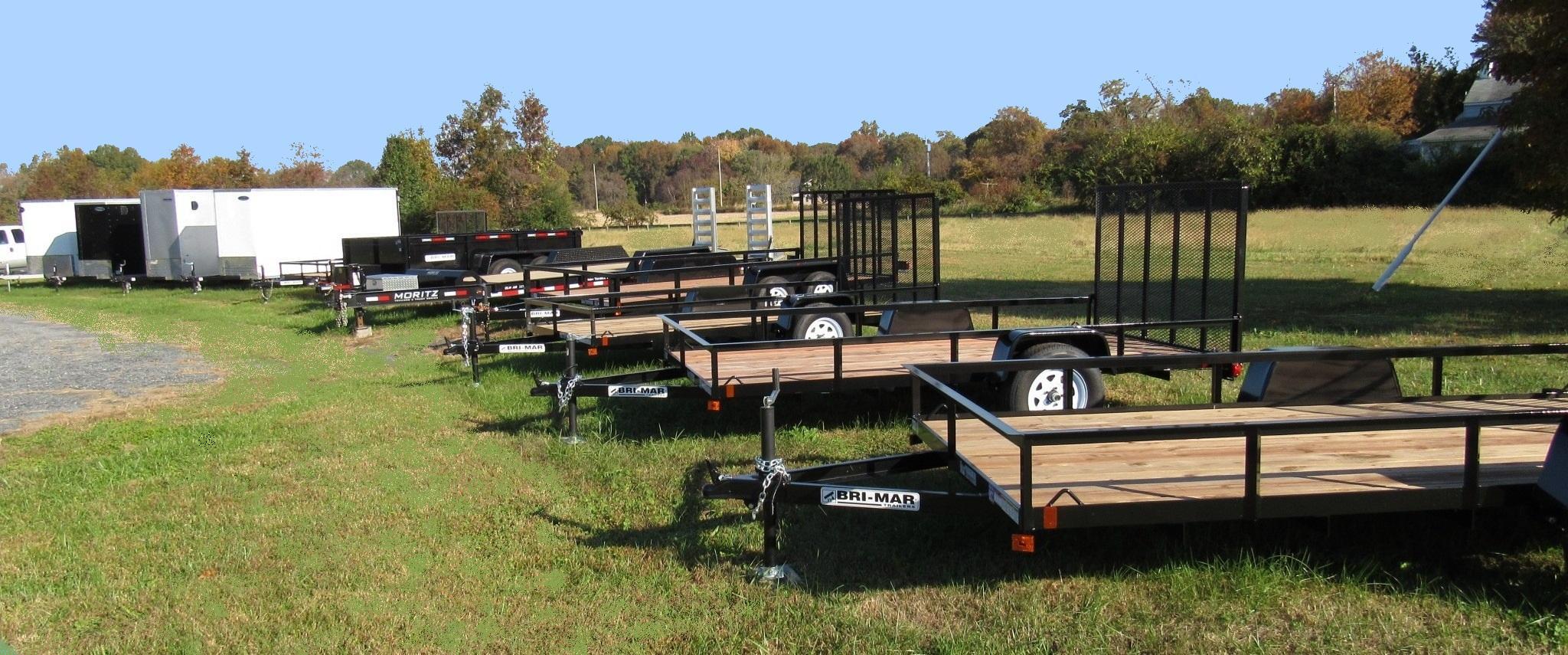







_small.jpg)





















_small.jpg)
